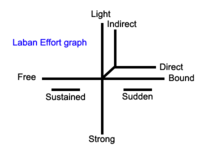Labanotation
|
|
Labanotation, or Kinetography Laban (as it is known in some parts of Europe) is a system of movement notation that is also used for dance notation. Invented by Rudolf Laban, it is one of the two main systems of movement notation used in Western culture.
Labanotation uses abstract symbols to define:
- the direction of the movement
- the part of the body doing the movement.
- the level of the movement
- the length of time it takes to do the movement
The shapes of the symbols indicate nine different directions in space and the shading of the symbol tells you the level of the movement.
The symbols are placed on a vertical staff, the horizontal dimension of the staff represents the symmetry of the body, and the vertical dimension time. The location of the symbol on the staff defines the body part it represents. The centre line of the staff represents the centre line of the body, symbols on the right represent the right side of the body, symbols on the left, the left side.
The staff is read from bottom to top and the length of a symbol defines the duration of the movement. Drawing on western music notation, Labanotation uses bar lines to mark time measures and double bar lines at the start and end of the movement score. The starting position of the dancer can be given before the double bar lines at the start of the score.
spatial distance, spatial relationships, transference of weight, centre of weight, jumps, turns, body parts, paths, and floor plans can all be notated by specific symbols.
Although the abstract symbols represent Laban's work on shape Laban's theories of effort (see Laban Movement Analysis) can also be represented in Labanotation, the four effort categories are:
- Space: Direct / Indirect
- Weight: Strong / Light
- Time: Sudden / Sustained
- Flow: Bound / Free
and they appear in the notation as an effort graph
The basic difference between Kinetography Laban and Labanotation is how the system is perceived:
- Those practicing Kinetography Laban (International Council of Kinetography Laban (http://www.ickl.org/)) believe that the system is based on spatial analysis.
- Those practicing Labanotation (The Dance Notation Bureau (http://dancenotation.org/DNB/)) believe that the system was developed to record body movement.
It is this difference that explains the differing interpretations of the notation by the two groups.
Labanotation is used in a variety of settings including Laban Movement Analysis, dance notation, documentation and reconstruction, Movement analysis, Robotics, Human movement simulation and Human movement synthesis.
Motif Description is a subset of Labanotation that depicts the overall structure or essential elements of a movement sequence.
Related articles
- Rudolf Laban
- Irmgard Bartenieff
- Laban Movement Analysis
- Motif Description
- movement notation
- dance notation
- choreography
External links
- Laban Lab (http://www.dance.ohio-state.edu/labanlab/) (learn the basics of Labanotation)
- Introduction to Labanotation (http://www.rz.uni-frankfurt.de/~griesbec/LABANE.HTML)
- Motif Description (http://dancenotation.org/DNB/lnbasics/motif.html)
- Language of Dance® (http://www.lodc.org/mainpage.html) Adaptation of Motif Description
- The Dance Notation Bureau (http://dancenotation.org/DNB/)
- International Council of Kinetography Laban (http://www.ickl.org/)
- Laban/Bartenieff Institute of Movement Studies (http://www.limsonline.org/)
- Integrated Movement Studies (http://www.imsmovement.com/) (Laban/Bartenieff)
- LabanWriter (http://www.dance.ohio-state.edu/labanwriter/) - Labanotation editor for Apple Macintosh OS 8.6 +
- LED and LINTER (http://www-staff.mcs.uts.edu.au/~don/pubs/led.html) - a UNIX and X windows mini-editor and interpreter for Labanotation
- Calaban (http://www.bham.ac.uk/calaban/frame.htm) - AutoCAD Labanotation editor for Microsoft Windowsde:Labanotation

